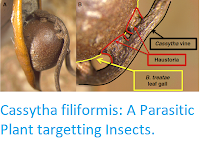The genus Sapria currently contains three species of Parasitic Plants closely related to the Corpse Flowers, Rafflesia spp.. Like Corpse Flowers, all members of the genus Sapria are parasitic on vines of the genus Tetrastigma,
with almost the entire body of the parasite reduced to a haustorium
that grows within the tissue of the host. The only part of the parasite
that extends outside the host is the flower (and later the fruiting
bodies derived from this), though these flowers are exceptionally large
and distinctive. The genus Sapria differs from Rafflesia in the structure of its flowers; both genera have large floral chamber defined by a diaphragm. However similar floral chambers in Rafflesia and Sapria are constructed very differently. The diaphragm is derived from the petal whorl in Rafflesia, on the other hand, in Sapria it is derived from elaboration of a ring structure located between the perianth and the stamen whorl.
In a paper published in the journal Taiwania on 20 August 2019, Nobuyuki Tanaka of the Department of Botany at the Japanese National Museum of Nature and Science, Hidetoshi Nagamasu of the Kyoto University Museum, Shuichiro Tagane of the Kagoshima University Museum, and Mu Mu Aung, Aung Khaing Win, and Phyu Phyu Hnin, of the Forest Research Institute of the Myanmar Ministry of Natural Resources and Environmental Conservation, describe a new species of Sapria from Kachin State, Myanmar.
The new species is named Sapria myanmarensis, meaning 'from Myanmar'. The plant lives entirely within the roots of Tetrastigma, until it flowers during the dry season (i.e. December till March), when it produces a pink bud that grows to 7 cm in diameter, which opens to produce a red flower with white warts, 10 cm in diameter.
Sapria myanmarensis, female flower. Tanaka et al. (2019).
The plant was found growing in an evergreen forest in a hilly area of the Indawgyi Wildlife Sanctuary. Less than 50 plants were found in total, and Tanaka et al, recomend that the species be classified as Critically Endangered under the terms of the International Union for the Conservation of Nature’s Red List of Threatened Species. I
See also...
Follow Sciency Thoughts on
Facebook.







